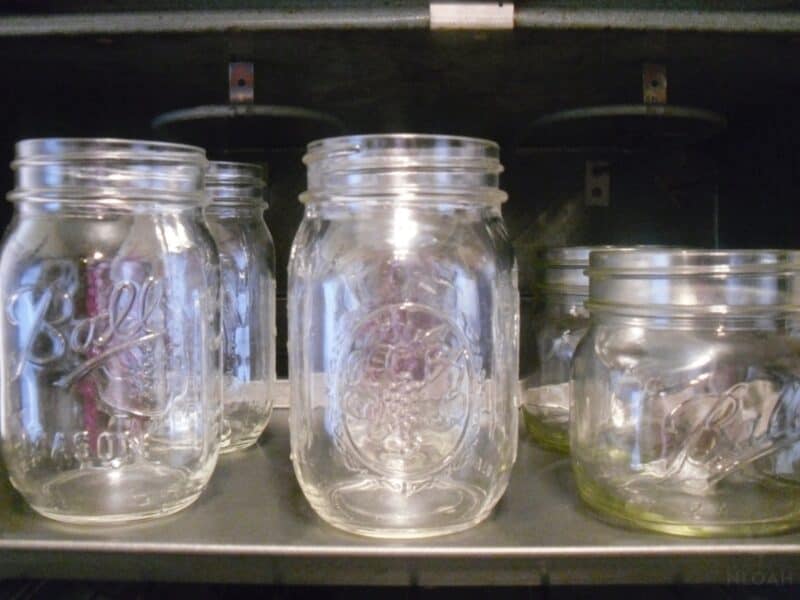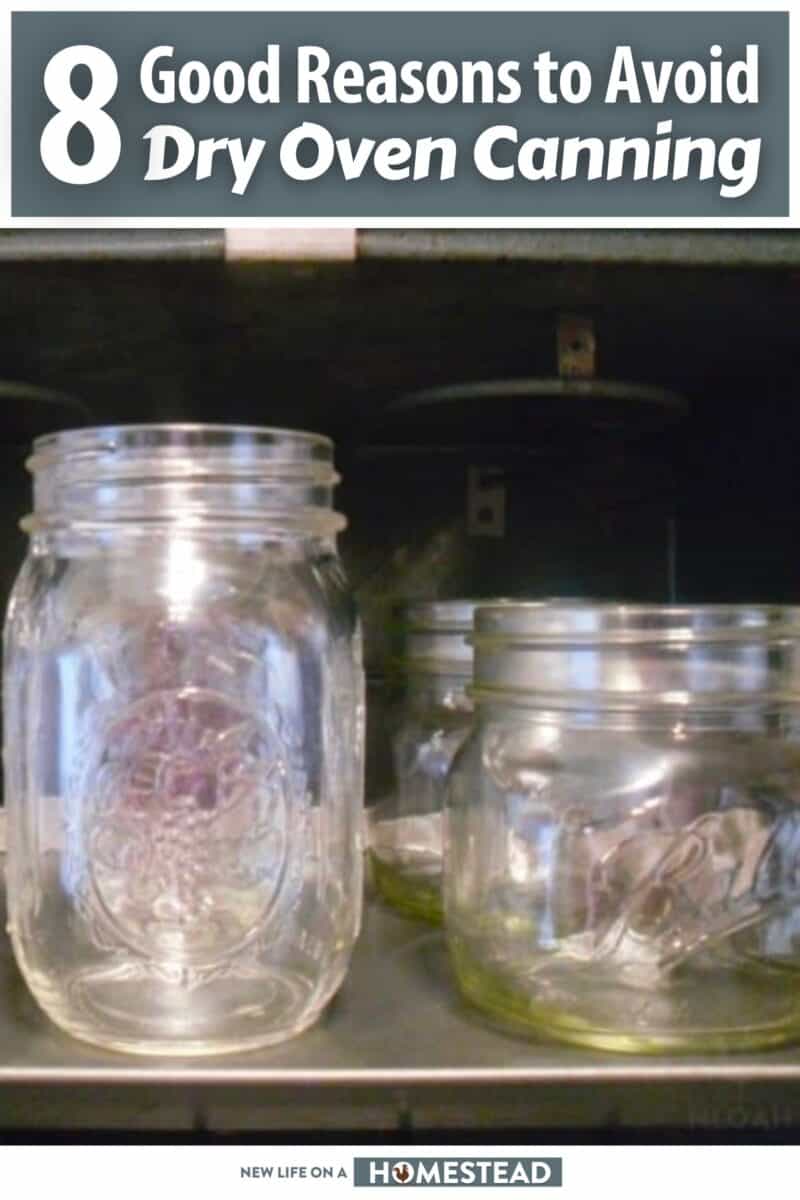Dry oven canning involves placing dry foods like beans, nuts, and grains into canning jars and sealing them. The sealed jars are then placed in an oven which is heated to 200 degrees Fahrenheit (93 Celsius).

This is supposed to preserve and extend the shelf life of whatever’s in the jar by removing all the moisture. No moisture means there’s nowhere for mold to grow and become a problem.
Now, you’d think this would work, and work well, except it doesn’t. In fact, it causes more problems than it solves.
Let’s discuss those problems as we explore the harsh truth about the safety of dry oven canning, shall we?
Table of Contents:
1. No Proof
Let’s start off slowly and discuss the evidence that supports dry canning – there isn’t any. No, I’m not kidding, there’s no research-based study that supports dry oven canning as a viable method of food preservation.
2. Not Recommended
Most products nowadays have a label that explains what can be done with the said product (think of the labels that tell you how to wash your clothes).
Glass jars have the same thing. If you buy in bulk, the box will tell you how much heat the glass can take.
3. The Glass May Shatter in the Oven
Dry oven canning is incorrectly listed as a method of preserving meat and poultry.
Meat, poultry, and other low-acid foods require temperatures higher than 212 degrees Fahrenheit (100 Celcius) or higher.
Now, that might not sound like much, but the jars are generally not meant to handle that kind of heat.
So, what happens when expose those jars to that kind of heat? Well, they’ll shatter or explode in your oven and put glass everywhere.
4. Ovens aren’t Pressure Chambers
Okay, so we’ve talked about how jars may explode in your oven, but the other problem is that ovens aren’t pressure chambers.
This means that the jars won’t get hotter than the boiling point of water – 212F (low-acid foods need temperatures of 212+ F). This is true regardless of the temperature inside the oven.
5. Lack of Accurate Heat Measurement
The thermometer on your oven isn’t exactly the best thing to use for canning. Why? Well, for starters it’s inaccurate.
You also can’t check the air circulation without removing the lid of the jar to check its internal temperature – which, of course, compromises the whole process.
6. A Source of Mold and Bacteria
A serious problem with any food is the formation of bacteria and/or mold – specifically black mold. Unfortunately, dry oven canning is a major source of both.
Now, we all know what evaporation is, right? All foods (even dry ones) have moisture in them and the heat from the oven releases that moisture, it becomes vapor and floats away.
If your jar is open (some instructions say to seal the jars after heating), that moisture can evaporate. On the other hand, if your jar is sealed, that moisture has nowhere to go and will form pockets in the jar.
As the jar cools, condensation forms inside the jar. The condensation and moisture pockets lead to the formation of mold.
Additionally, the jars become a veritable breeding ground for bacterial spores – notably Salmonella and Clostridium Botulinum.
7. Botulism and Salmonella Poisoning
Salmonella is resistant to drying and while infections are common and nasty and they are rarely fatal.
Salmonella infections typically cause cramps, fever, diarrhea, and general discomfort. They’re more of an inconvenience than anything, unpleasant and annoying but nothing to worry about.
They’ll typically clear up on their own in a few days, so most people don’t need to seek medical help.
Clostridium Botulinum forms the botulinum toxin which causes botulism.
Now, botulism is the exact opposite of salmonella infection. It’s much worse, symptoms include nausea, diarrhea, blurred vision, and breathing difficulty.
If you contract botulism, you should seek medical help ASAP as it can be fatal if left untreated.
8. Shortens Shelf-Life
Some places say that you can dry can anything with less than 10% moisture (i.e. rice, dry beans, wheat, oatmeal, etc.) and it’ll last for a good while.
Unfortunately, that’s not the case. Dry oven canning actually shortens the shelf life of your food.
Why? Well, that’s simple because you’re exposing food to heat.
I know that sounds weird so let me explain. When you want to preserve food, there are things that you’ll want to avoid – that’s obvious.
Apart from the regular bugs, you’ll want to avoid exposure to heat, air, and light. You see the problem here?
If you want to avoid exposure to heat, why would you use a method that requires a temperature of 212+ degrees Fahrenheit?
Additionally, the longer the jars are in the oven – apart from the risk of shattering/explosion – the heat depletes the nutrients of the food you’re trying to preserve.
Alternative Methods
There are a couple of different methods that work better than dry oven canning
1. Water Bath Canning
Water bath canning involves placing jars of food in boiling hot water.
Something to keep in mind is that this method is only safe for highly acidic foods i.e. fruit-based jams, tomatoes – anything with a PH of 4.0. Any other, un-pickled foods need to go through a pressure canner.
The reason for this is that the water is at the acidity of the food which allows it to help in preserving food, but it cannot guarantee that the food will be safe to eat.
2. Pressure
Pressure canning also involves placing jars of food in boiling water, but you also need a pressure canner.
This method allows you to can low acid/alkaline foods i.e. meats which would be dangerous to can in boiling water.
Using a pressure canner is a must with these types of foods. Why? Because clostridium botulinum and the resulting toxin are destroyed in boiling water, its spores, however, can survive.
These spores require a moist, oxygen-free environment to release the botulinum toxin, which is exactly what they get in sealed jars.
A pressure canner can heat the food inside the jars to a temperature high enough to kill the botulinum spores.
3. O2 Absorbers and Vacuum Sealers
This isn’t really a canning method, but it follows a similar concept. Put the food in a sealing bag and suck all the oxygen out of the bag.
No oxygen means there’s nothing that will allow mold to grow. Your food is preserved (usually you’d stick it in your freezer or pantry) until you need it and is relatively safe.
I say “relatively” because unfortunately, the lack of oxygen does NOT prevent the appearance of Clostridium Botulinum in your jars.
That nasty menace thrives in an oxygen-free environment and has no taste or smell to it; meaning you won’t know it’s there until you’re sick.
Heating your food at 180 degrees for 10+ minutes should kill off the bacterial spores.
The Harsh Truth about Dry Oven Canning
The harsh truth about dry oven canning is that it’s just not a safe method of canning to use.
It’s a method that poses serious health risks which can range from minor annoyances like salmonella infections to something more serious (i.e. botulism).
There’s also the risk of personal injury and damage to your oven if/when the jars shatter.
All in all, there are much safer methods of preserving your food so why would you risk your health?
It also doesn’t preserve your food or extend its shelf life. The reality is Dry oven canning actually shortens your food’s shelf life.
I hope you all enjoyed the article and that it helps you out in some way. As always, thanks for reading and I’ll see you next time!
Take care!


Greg is a South African farmer and homesteader who’s been around animals ever since he can remember. He’s also an avid camper and hiker.
